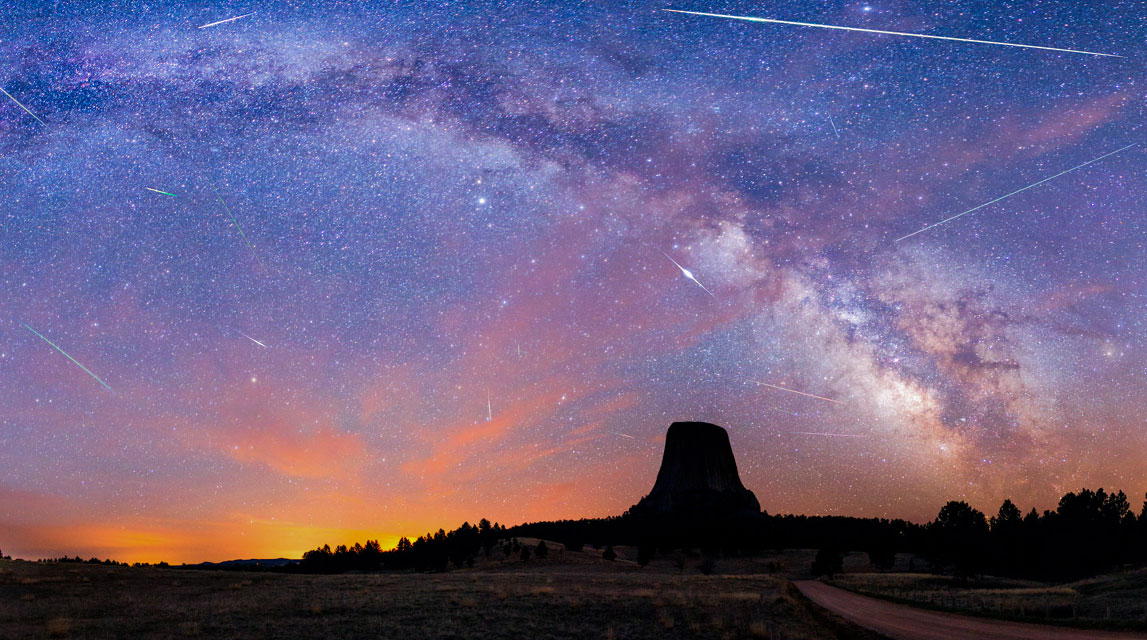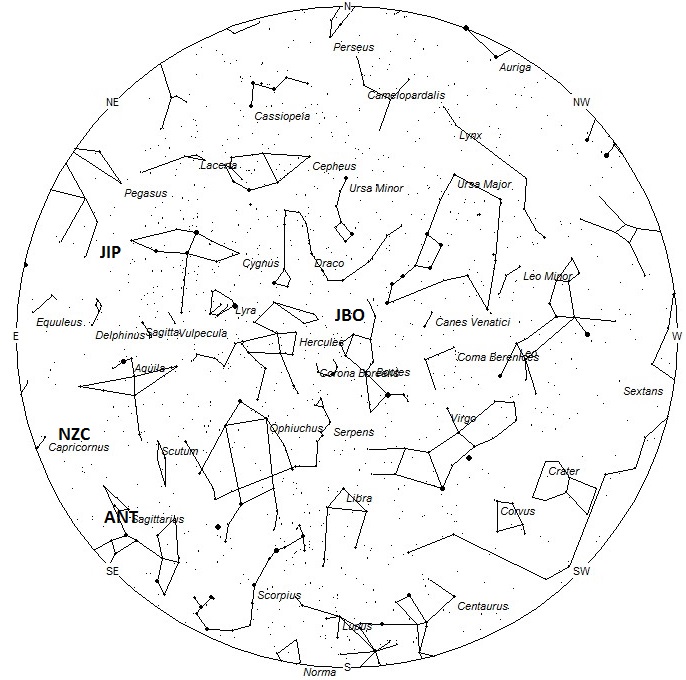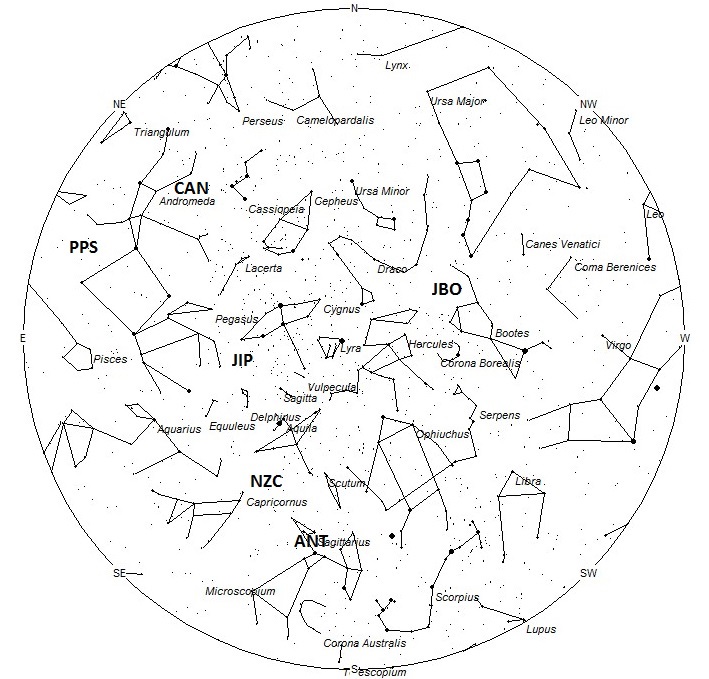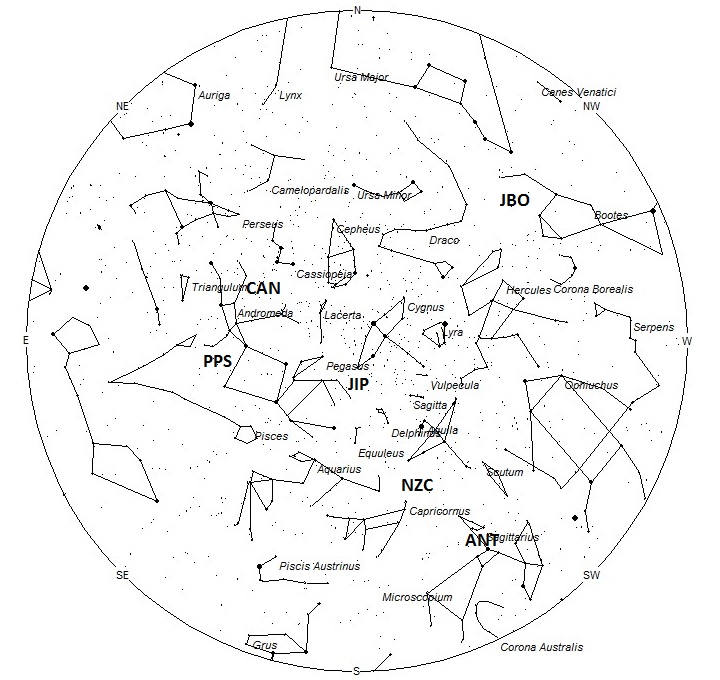
During this period the moon will reach its new phase on Friday June 23. At this time the moon will lie near the sun and will not be visible at night. Later in this period the waxing crescent moon will enter the evening sky but will not interfere with meteor observing, especially during the more active morning hours. The estimated total hourly meteor rates for evening observers this week is near 3 for those viewing from the northern hemisphere and 4 for those located south of the equator. For morning observers the estimated total hourly rates should be near 9 as seen from mid-northern latitudes (45N) and 12 as seen from tropical southern locations (25S). The actual rates will also depend on factors such as personal light and motion perception, local weather conditions, alertness and experience in watching meteor activity. Note that the hourly rates listed below are estimates as viewed from dark sky sites away from urban light sources. Observers viewing from urban areas will see less activity as only the brightest meteors will be visible from such locations.
The radiant (the area of the sky where meteors appear to shoot from) positions and rates listed below are exact for Saturday night/Sunday morning June 24/25. These positions do not change greatly day to day so the listed coordinates may be used during this entire period. Most star atlases (available at science stores and planetariums) will provide maps with grid lines of the celestial coordinates so that you may find out exactly where these positions are located in the sky. A planisphere or computer planetarium program is also useful in showing the sky at any time of night on any date of the year. Activity from each radiant is best seen when it is positioned highest in the sky, either due north or south along the meridian, depending on your latitude. It must be remembered that meteor activity is rarely seen at the radiant position. Rather they shoot outwards from the radiant so it is best to center your field of view so that the radiant lies at the edge and not the center. Viewing there will allow you to easily trace the path of each meteor back to the radiant (if it is a shower member) or in another direction if it is a sporadic. Meteor activity is not seen from radiants that are located far below the horizon. The positions below are listed in a west to east manner in order of right ascension (celestial longitude). The positions listed first are located further west therefore are accessible earlier in the night while those listed further down the list rise later in the night.
These sources of meteoric activity are expected to be active this week.
.
The June Bootids (JBO) are usually a very weak shower that occasionally produces outbursts. Nothing out of the ordinary is expected this year. These meteors are best seen from June 23-25 with maximum activity occurring on the 24th. At maximum the radiant is located at 14:58 (224) +48. This position lies in northwestern Bootes, 15 degrees east of the second magnitude star known as Alkaid (Eta Ursae Majoris). This radiant is best placed in the evening sky just as the sky becomes dark. Observers in the northern hemisphere have a distinct advantage over those located south of the equator as the radiant lies much higher in the evening sky. No matter your location, little activity is expected from this source. With an entry velocity of 18 km/sec., the average June Bootid meteor would be of very slow velocity.
The center of the large Anthelion (ANT) radiant is currently located at 19:04 (286) -23. This position lies in central Sagittarius, 1 degree southwest of the 4th magnitude star known as omicron Sagittarii. Due to the large size of this radiant, Anthelion activity may also appear from the nearby constellation of Scutum as well as southern Ophiuchus . This radiant is best placed near 0200 local daylight saving time (LDT), when it lies on the meridian and is located highest in the sky. Hourly rates at this time should be near 2 as seen from mid-northern latitudes and 3 as seen from tropical southern latitudes. With an entry velocity of 30 km/sec., the average Anthelion meteor would be of slow velocity.
The Northern June Aquilids (NCZ) were discovered by Zdenek Sekanina. These meteors are active from June 5-July 22, with maximum activity occurring on the July 3. The current position of the radiant is 20:08 (302) -07. This position lies in southwestern Aquila, 6 degrees northwest of the naked eye double star known as Algiedi (Alpha Capricorni). Current rates are expected to be near 1 per hour, no matter your location. With an entry velocity of 38 km/sec., the average Northern June Aquilid meteor would be of medium speed.
The June iota Pegasids (JIP) were discovered by John Greaves using data from the SonotaCo Network in Japan. This is a short duration display with meteors being visible only on 5 nights centered on June 25. The position of the radiant is 22:12 (333) +29. This position lies in northwestern Pegasus, 4 degrees north of the 4th magnitude star known as iota Pegasi. Rates are expected to be less than 1 per hour, no matter your location. With an entry velocity of 59 km/sec., the average June iota Pegasid meteor would be of swift speed.
The phi Piscids (PPS) were discovered by Dr. Peter Brown in his meteoroid stream survey using the Canadian Meteor Orbit Radar. This shower was later verified by Dr. Peter Jenniskens and David Holman using data from the CAMS network in northern California. These meteors are active from June 8 through August 2 with maximum activity occurring on July 5. The current position of the radiant is 00:32 (008) +21. This position lies in in north-central Pisces, near the group of faint stars known as 52, 54, and 55 Piscium. Rates are currently expected to be less than 1 per hour no matter your location. With an entry velocity of 66 km/sec., the average Pi Piscid meteor would be of swift speed.
The first of the c-Andromedids (CAN) should be seen this week. This stream was discovered by Sirko Molau and Juergen Rendtel using video data from the IMO network. Activity from this source is seen from June 26 though July 27 with maximum activity occurring on July 9. The radiant currently lies at 00:54 (013) +43, which places it in northern Andromeda, just 2 degrees north of the faint star known as nu Andromedae. This position is also just 2 degrees northeast of the naked eye Andromeda Galaxy. This area of the sky is best seen during the last dark hour before dawn when the radiant lies highest in a dark sky. Observers in the northern hemisphere are better situated to view this activity as the radiant rises much higher in the sky before dawn compared to southern latitudes. Current rates would be less than 1 per hour no matter your location. With an entry velocity of 58 km/sec., the average meteor from this source would be of swift velocity.
As seen from the mid-northern hemisphere (45N) one would expect to see approximately 7 sporadic meteors per hour during the last hour before dawn as seen from rural observing sites. Evening rates would be near 2 per hour. As seen from the tropical southern latitudes (25S), morning rates would be near 9 per hour as seen from rural observing sites and 3 per hour during the evening hours. Locations between these two extremes would see activity between the listed figures.
The list below offers the information from above in tabular form. Rates and positions are exact for Saturday night/Sunday morning except where noted in the shower descriptions.
| SHOWER | DATE OF MAXIMUM ACTIVITY | CELESTIAL POSITION | ENTRY VELOCITY | CULMINATION | HOURLY RATE | CLASS |
| RA (RA in Deg.) DEC | Km/Sec | Local Daylight Saving Time | North-South | |||
| June Bootids (JBO) | Jun 24 | 14:58 (224) +48 | 18 | 22:00 | <1 – <1 | III |
| Anthelions (ANT) | – | 19:04 (286) -23 | 30 | 02:00 | 2 – 3 | II |
| Northern June Aquilids (NCZ) | Jul 03 | 20:08 (302) -07 | 38 | 02:00 | <1 – <1 | IV |
| June iota Pegasids (JIP) | Jun 25 | 22:12 (333) +29 | 59 | 04:00 | <1 – <1 | IV |
| phi Piscids (PPS) | Jul 02 | 00:32 (008) +21 | 66 | 07:00 | <1 – <1 | IV |
| c-Andromedids (CAN) | Jul 09 | 00:54 (013) +43 | 58 | 07:00 | <1 – <1 | IV |
 American Meteor Society
American Meteor Society



My dad believes he just saw an asteroid hit in Shelby county area. Do you know anything about it? He said it was huge then heard the impact
Your dad most likely witnessed a fireball related to event #2081 for 2017. We have 63 reports of this object so far spread over a large swath of land stretching from Missouri to West Virginia. Check out details on this event at: http://www.amsmeteors.org/members/imo_view/event/2017/2081
Robert Lunsford
I saw one June 25 shortly after 2200 Newfoundland time, I was facing a southerly direction on the southern shoreline of the Avalon Peninsula it came down fairly straight towards the ocean. I was a fair distance from my location but really bright. I heard a strange noise turned and saw it dropping really fast.